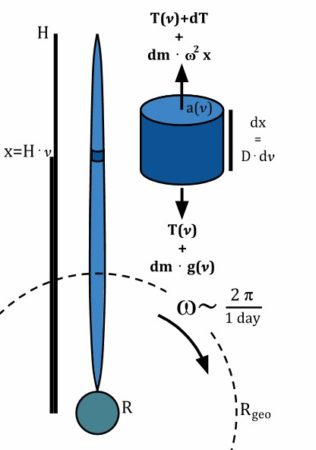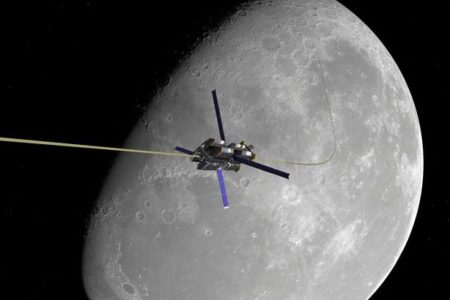August 31, 2019 – In past postings, I have written about schemes to build a space elevator, a way to get from Earth to space without the use of chemical-powered rockets. But what Columbia and Cambridge University researchers are proposing they call the Spaceline. Instead of traveling from Earth to space, the line would travel from the Moon to a geostationary endpoint above the Earth. We would still use our chemical rockets to send payloads aloft but we wouldn’t have to travel beyond the Spaceline endpoint, a depot just like a railway station.
In a paper being prepared for publication in Acta Astronautica, Zephyr Penoyre of the University of Cambridge’s Institute of Astronomy, and Emily Sandford of Columbia University’s Department of Astronomy, point out their alternative to the classic space elevator which they believe is impossible to build using today’s materials because the motion of the Earth would put such stress on it that it would snap. Instead, by anchoring a space elevator from the surface of the Moon, and constructing the cable to an Earth geostationary endpoint, the cost of payload deliveries to Deep Space and the lunar surface would be considerably lower.
A cable from the Moon would circumvent the problem of trying to build something strong enough to overcome the centrifugal forces exerted on it if it were extended from Earth to an orbital endpoint. The researchers state that “a cable which only hangs into Earth’s gravitational well need not be thick or massive.” Instead, it can be tapered (see schematic that follows) to be of varied thickness as it traverses from the Moon to an endpoint depot above Earth. The key to ensuring the Spaceline’s endurance would be to keep maximum tension on the entire length of the line.

The researchers don’t envision just a one station Spaceline. A second depot would be established at a Lagrange libration point in the vicinity of the Moon where the forces of motion and gravity would be neutralized to ensure the durability of the line. From there a uniform cable would descend to a destination depot on the Moon’s surface.
In their paper, the researchers argue “that we have the materials and technology today…necessary to support a spaceline construction.” All that remains to be addressed is “the practical constraints on such a construction and its potential uses.”
Why build the Spaceline?
It could cost billions of dollars to construct but would we gain a long term advantage in building it? These are some of the dividends:
- Lower transport costs – The launch costs and fuel to get to the geostationary endpoint represent the biggest expenditure. Once at the depot, however, transportation along the line would be free using solar-powered climbing vehicles like the freight cars used in train lines. This means reduced costs for moving large payloads to the near-Moon space and its surface. The estimated saving in fuel alone would be a third of the cost.
- A Simpler Infrastructure – Because objects in space are subject to microgravity and float freely navigation from the Earth to the Moon requires a degree of complexity. But the Spaceline takes the navigation issue out of the picture because motion between the depots would be linear.
- Space transport gets simplified – Payloads of variable size can travel along the line from different depots. From the Lagrange depot, a delivery from Earth can be broken down into smaller loads destined for the Moon surface. In the same way, small loads can be sent up from the Moon to the Lagrange depot and assembled to head down the line back to the geostationary depot above Earth. Minimizing the need for spaceflight to achieve this will have a similar impact to how railways led to the industrialization and growth of countries on Earth.
- Increased space technology capacity – The engineering challenges the Spaceline would present would encourage technological innovation with enormous downstream benefits. Think of how the Apollo Program ended up producing technological innovation in the latter part of the 20th century, from velcro to home computers.
- The Lagrange point depot will become more than a Spaceline station – The researchers argue that the Lagrange point depot will serve to become a launch point for further human space exploration and habitation. Just as railway stations served as hubs to attract new businesses nearby, this depot will serve as a gravity-free environment for the construction of Deep Space habitats and an assembly point for equipment for use in building additional space infrastructure on a scale that would have seemed impossible if built in Earth orbit or on the Moon. One can imagine that scientists and engineers could use the depot as a base camp for space-based research. Imagine equipment being constructed here to look further into space, to study gravitational waves, and to be a launch point for both robotic and human missions to the rest of the Solar System. At the Lagrange point depot, there would be no constraints on the size of the technology built for human habitation or for exploration. In effect, it could become the hub and centre for a city in space.
















